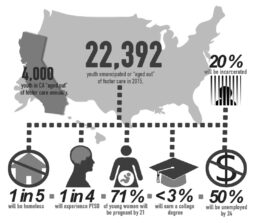Students and teachers discuss their opinions on flex time after a semester’s experience
By Jack Loar, Monica Mai, Emily Mao, Sameer Jain, Carolyn Ku, and Emily Shen
Last semester, Aragon teachers voted 62 to 12 in favor of a referendum to implement flex time — a 35-minute school-wide mandatory study period — into the block day schedule, replacing the 15-minute office hours period on Wednesday, removing five minutes from each block period, removing one minute from passing period, and adding 20 minutes to the Thursday school day.
In a survey conducted by the Outlook, 88.4 percent of surveyed students believed that flex time was helpful, and 85.9 percent of students believed they were productive during the period.
The most common uses for flex time, according to surveyed students, are homework, getting help from teachers, and making up tests, in that order.
On its implementation, Principal Pat Kurtz says, “I think it is going well, having talked to students anecdotally, and most will tell me that it gives them time to either work on homework, get some extra help, or take some test that they missed due to activities or athletic events or [other reasons].”
Two tiers of flex time aim to address the diverse needs of the student body.
Dedicated flex time
During dedicated flex time, students have the opportunity to study in a classroom of their choice, make appointments with their teachers, make up tests and other classworks, and work more closely with their teachers to understand concepts.
Some students, like senior Jared Mayerson, develop a routine out of convenience. “Usually I go to Mr. Silton’s or [the] theater because they are quiet. Typically, I run a club in Mr. Daniel’s room on Thursdays at lunch, so typically every Thursday I go to Mr. Silton’s room, and coincidentally, my fourth is there. But usually on Wednesdays, I go to theater. I developed this routine because [these classrooms] are quiet places but also because they are also right near my previous class[es], so [I] don’t have to worry about being tardy, and it’s convenient.”
Flex time policies — appointment system, behavior expectations, students allowed — differ by teacher.
English teacher Tiffany Wang prioritizes students who make appointments with her using the online appointment system on the School Loop homepage, but since her classroom is not normally full, students can get help if they walk in. “My classroom is not normally filled up. If they reserve a spot, I meet with those students first, and then the rest of flex time is used for students who came in for help but hadn’t signed up.”
Math teacher Chelsea Rees appreciates when students use the appointment system and only permits her own students to use her room during flex because of issues with capacity. “My classroom is generally very full, and because of this, I only allow students in my room during flex who are currently in one of my classes. I appreciate when a student makes an appointment with me and specifies what they need help on. I can then make sure I have the materials or work needed to help them.”
Rees implemented this policy after noticing problems when she previously opened her doors during flex time to all students. “When I allowed any student in my classroom, it did not work well. I don’t have an established relationship with them, and therefore they don’t know my policies.”
Social science teacher Amanda Klein also comments on her classroom expectations during flex time, saying, “There is probably a lower standard during flex. Students are having non-academic conversations more, and are less focused on their work during flex than during class. I’m not totally against this however, as sometimes students need the mental break, and a lot of their talk and action is still focused on school and schoolwork. I have not had to take disciplinary action.”
One policy that has worked for special education teacher Carl Pastore lets him make sure his students will be on task as soon as they walk into his door. “If students are going to come in my room, they need to have work to do,” says Pastore. “I ask them what work they have to complete. If they say nothing, I don’t let them in the room.”
Klein notices that students who enter her classroom during flex in groups may not always be productive. “I’m sometimes not sure I should let in students I don’t have in class who come with their friends. Sometimes, [but not always], it is not adding to the productivity.”
English teacher Genevieve Thurtle praises the addition of flex time, saying, “I think flex time has provided a great service to our students, and that service is a simple, but essential one: giving them the space and time to attend to their needs as students. I can’t imagine taking it away from them. Having flex time sends a critical message to our students: that Aragon understands the academic demands it places on them and is willing to give them the resources they need, like time and access to teachers, that will help them meet these rigorous demands successfully.”
Intensive flex time
Intensive flex time is geared towards academically struggling students by providing them with a designated space to work (formerly the Student Lunchroom, now in the library) and student tutors to help them with their schoolwork.
Intensive flex period, or tutorial, is mandatory for students with two or more F grades on their six-week progress report. Students stay in intensive flex until they raise their grades to all Cs or better.
Tutor Club members and other volunteers who applied to be flex time tutors in the beginning of the school year assist these students in intensive flex. AVID teacher and Tutor Club adviser Cristina Trujillo says, “When the school decided they wanted to do flex time, and they wanted some kind of a component for having tutors available in the flex time tutorial, I knew that I had had a group of students that were a pool of candidates that could work for that.”
Flex time tutors are required to tutor for two flex periods a month. “They are supposed to walk around, see if anybody needs help. If somebody needs help they sit down with that student who is asking for some tutoring help, and then they work with that student as long as the student requests their services,” explains Trujillo.
Trujillo reflects on the qualifications of the students volunteering for the tutoring program, saying, “All of the recommendations were stunning coming from the teachers so I think…the students who apply…know themselves very well…if you are going to apply for that kind of a role, you have an inclination to be helpful to people. And just having that inclination sometimes is the first step in getting that kind of a role started successfully.”
Survey results
15.6 percent of current, surveyed students who were also students last year say they never talked to teachers after school, during lunch, or during the 15-minute office hours period last year.
76.5 percent of students believe flex time reduces the time they spend on schoolwork after school.
89.3 percent of students believe their teachers are available during flex time if they need help.
53.1 percent of students usually spend flex time in the same room.
87.1 percent of students believe flex time is worth shorter classes on block days.
60 percent of students believe flex time is worth the extended Thursdays.
The Outlook conducted a voluntary online student survey with a sample size of 588 students in October 2015.



